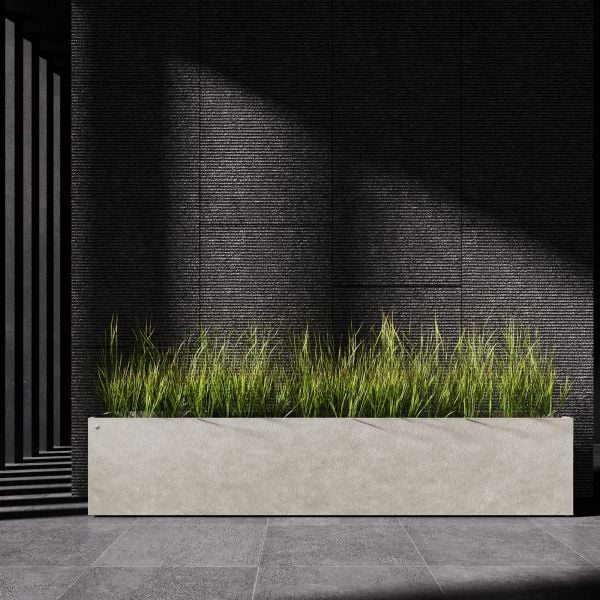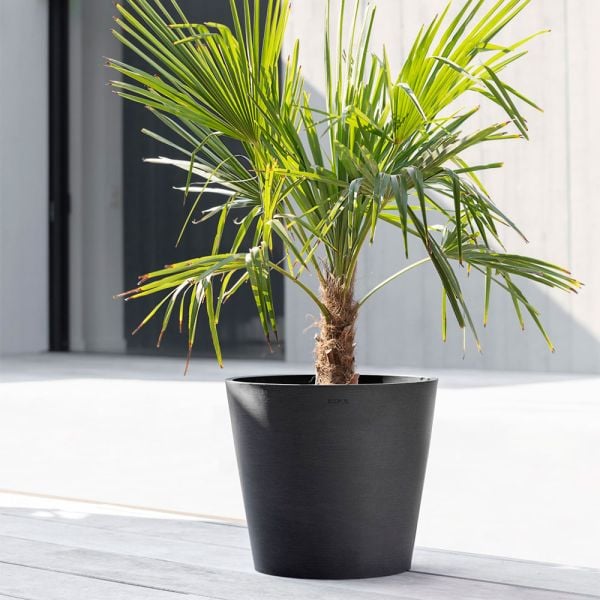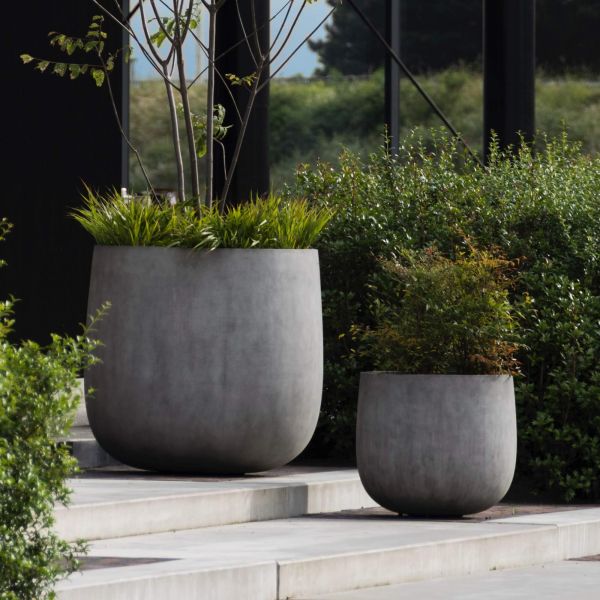3 Tips for Successfully Growing Hostas in Pots

Hostas, also known as a plantain lily, are a stunning, shade-loving perennial that can easily elevate any indoor plant arrangement with their lush foliage and delicate flowers. With a variety of colors, sizes, and textures to choose from, hostas are an excellent choice for interior designers and plantscapers looking to add depth and dimension to indoor spaces. Whether your client is seeking a low-maintenance yet beautiful indoor plant or a leafy companion for a shady patio, hostas are a versatile option that thrives in pots. Here are three key tips for successfully growing hostas in containers.
1. Choose the Right Pot and Soil for Your Hosta Houseplant
When selecting the best pots for hostas, it’s important to give these plants room to spread their roots. Hostas need large containers that allow their root system to grow freely. A pot should be at least 18 inches deep to accommodate the hosta’s roots, and the pot’s width should match the expected spread of the foliage. For hostas in containers, choosing a pot that’s too small can restrict root growth and stunt the plant’s development, resulting in your vision for the design to fall flat.
In terms of soil, the best soil for hosta plants is rich in organic matter and well-draining. A mix with peat moss will retain moisture while preventing water from stagnating, which is crucial for avoiding issues like root rot. Hostas are also heavy feeders, so adding a slow-release fertilizer or incorporating regular feeding into your hosta plant care routine is key to helping them thrive for your clients. Be sure to choose soil that is sterilized to avoid any fungal issues that could damage your hosta houseplant.
Looking for a hosta container? Here are a few of our favorite planters for this shade-loving plant:
2. Provide the Right Growing Conditions for Hosta Plants
Indoor hostas prefer indirect light, which makes them ideal for spaces that don’t receive direct sunlight. Whether in a low-light corner or near a north-facing window, indoor hostas can flourish in these conditions. Direct sunlight can burn the delicate foliage of your potted hostas, so ensure they receive bright, indirect light for the best results.
Additionally, understanding the growing conditions for hosta plants is crucial. While hostas can tolerate a variety of light conditions, their leaf color can change depending on how much light they receive. Blue and gray hosta varieties are typically more sensitive to light and can lose their vibrant hues if exposed to too much direct sunlight. Always consider the specific variety of hosta you’re working with and place it accordingly in the space.
Watering is another critical element of hosta plant care. While hostas prefer consistently moist soil, overwatering can lead to issues such as crown rot. To maintain the right moisture balance, consider using a sub-irrigation system for your hostas in pots, which helps prevent waterlogging while ensuring the roots stay hydrated. This is especially important when growing hostas indoors, as environmental conditions tend to be drier than outdoors.
3. Repotting and Winter Care for Potted Hostas
As with any plant, potted hostas need to be repotted as they grow. Over time, the roots of the hosta may outgrow the container, leading to stunted growth. Garden Guides recommends to check your potted hostas each spring and make sure the roots aren’t pressing up against the sides of the pot or growing out of the drainage holes. If they are, it’s time to repot into a container 2-4 inches larger than the current one. For hostas in containers, using larger pots will give the plant enough room to continue flourishing.
One of the unique aspects of hosta houseplant care is their requirement for a period of dormancy during the colder months. While most indoor plants thrive in a stable, warm environment, hostas require a cool rest period that mimics the natural winter conditions they would experience outdoors. In winter, move the hosta to a cool, dark space where temperatures remain below 40°F. During this dormancy period, you can also mulch the top of the container to retain moisture and protect the plant. After a few weeks, bring the hosta back to its regular indoor spot as the warmer spring temperatures arrive.
Design Tip: Consider Variegated Hosta Varieties for Added Visual Interest
One of the many reasons to love hostas in containers is the wide variety of cultivars and colors available, particularly the variegated hosta varieties. These hostas offer eye-catching patterns and color contrasts that can create visual interest in any plant arrangement. Variegated hostas come in a range of shades, from light green to deep blue, often with white, yellow, or cream edges. These unique colors add an extra layer of texture and depth to any interior design. Consider using a mix of these varieties to create stunning indoor plant displays that highlight different shapes and shades of foliage.
Frequently Asked Questions About Indoor Hostas
Can Hostas Be Grown Indoors?
Absolutely! Indoor hosta plants are an excellent choice for interior designers and plantscapers looking to add lush greenery to indoor spaces. Their shade-loving nature makes them perfect for areas with low light, such as offices, living rooms, and bathrooms. By incorporating hostas in containers or hostas in pots, you can easily create a vibrant, green oasis indoors. With the proper care, hostas will thrive and enhance any interior design.
Is Hosta a Good Houseplant?
Yes, hostas are a fantastic choice for indoor plant arrangements. These versatile plants are ideal for filling spaces with lush, leafy greenery and require minimal maintenance. Whether you’re working with a hosta houseplant in a low-light corner or using hostas in containers to add life to an indoor landscape, their variety of colors, including variegated hosta varieties, and broad, textured leaves will make a striking impact. With regular hosta plant care, they’ll continue to flourish indoors for years.
What Do Hostas Look Like in Winter Indoors?
In winter, indoor hostas enter a natural dormant phase. While the foliage may yellow and die back—ruining your design aesthetic—this is a normal part of the hosta plant care cycle. To maintain healthy plants, it’s important to simulate their natural dormancy period. Garden Guides recommends placing your hostas in pots or potted hostas in a cool, dark space with temperatures below 40°F, as this helps mimic their winter rest. By doing so, the plants will be ready to emerge with fresh growth in the spring, offering renewed vitality to your designs.
Why Is My Indoor Hosta Dying?
If your hosta houseplant is showing signs of decline, there could be several causes. Overwatering or underwatering is a common issue—both can lead to problems like root rot or dry, crisp foliage. Be sure to maintain consistent moisture levels, ensuring that the soil is moist but not waterlogged. Another factor is light: hostas need bright, indirect light to thrive. If your indoor space doesn’t provide enough, consider moving the plant to a location with better light or using grow lights. Finally, poor soil conditions or a lack of nutrients may also affect your plant’s health, so it’s crucial to use the best soil for hosta and ensure regular feeding to support healthy growth.
Are Hostas Poisonous to Dogs?
Good news for pet-friendly spaces: hostas are non-toxic to dogs! While it’s always wise to discourage pets from chewing on plants, hostas are safe for households with pets. Ingestion of large amounts may cause mild digestive upset, but in general, these plants pose no significant threat to animals. So, if you’re designing spaces where pets are present, hostas in containers can be a great choice.
Do Hostas Prefer Sun or Shade?
Hostas are best known for their love of shade. These plants naturally thrive in areas with indirect light, making them ideal for interiors that lack direct sunlight. Whether placed in a north-facing window or tucked into a shaded corner, indoor hostas will flourish in low-light environments. However, be cautious of too much direct sunlight, as it can scorch their delicate leaves. Incorporating hostas in pots or as part of larger plant arrangements allows you to place them where they’ll thrive.
What Is the Lifespan of a Hosta?
Hostas are long-lived plants, and with the right care, they can live for many years indoors. Whether you’re growing hostas in containers or incorporating them into larger designs, these plants can last a decade or more. It’s important to repot your potted hostas every 2-3 years, as they may outgrow their containers. Checking the roots in the spring and repotting into a larger pot ensures that they have enough space to continue growing. With proper hosta plant care, these plants will remain a beautiful addition to your indoor landscapes for years to come.
Final Thoughts about Hostas
By incorporating hostas in containers into your plant designs, you’ll provide your clients with stunning, easy-to-care-for plants that add vibrant greenery to any indoor space. Whether you choose variegated hosta varieties for a pop of color or rely on classic green varieties for a lush, leafy look, hostas offer versatility, beauty, and long-lasting appeal. With a bit of thoughtful care, you can enjoy thriving hostas in pots that will elevate any interior.
You May Also Like
2 responses to “3 Tips for Successfully Growing Hostas in Pots”
Leave a Reply
You must be logged in to post a comment.
























I have found hostas get spider mites easily indoors so spraying the foliage with water regularly is a must. I spray at least once a week if not more.
Thanks for the tip! It’s always important to stay ahead of the pests!